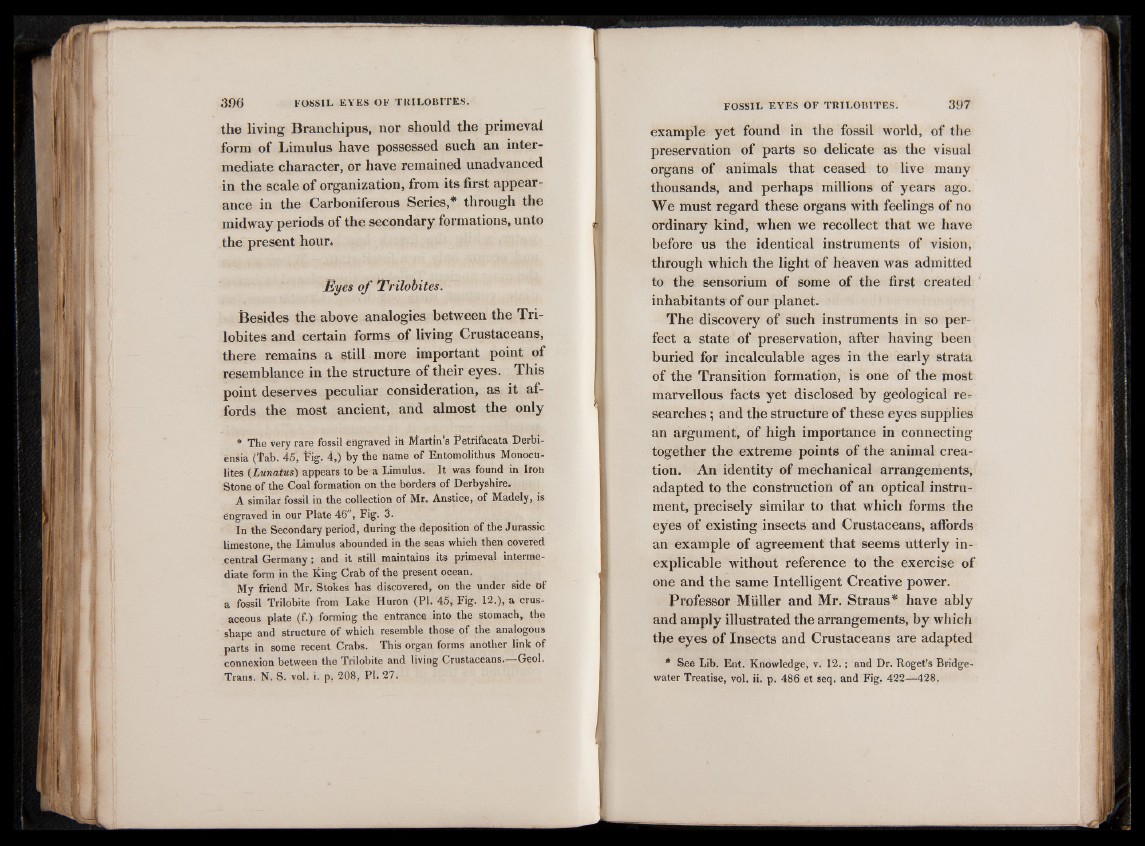
the living Branchipus, nor should the primeval
form of Limulus have possessed such an intermediate
character, or have remained unadvanced
in the scale of organization, from its first appearance
in the Carboniferous Series,* through the
midway periods of the secondary formations, unto
the present hour.
Eyes of 'Trilobites.
Besides the above analogies between the Trilobites
and certain forms of living Crustaceans,
there remains a still more important point of
resemblance in the structure of their eyes. This
point deserves peculiar consideration, as it affords
the most ancient, and almost the only
* The very rare fossil eilgraved ift Martin's Petrifacata Derbi-
ensia (Tab. 45, Pig. 4,) by the iiatne of Entomolithus MonocU-
lites (Lunatus) appears to be a Limulus. It was found in Ifoh
Stone of the Coal formation on the borders of Derbyshire.
A similar fossil in the collection of Mr. Anstice, of Madely, is
engraved in our Plate 46", Pig. 3.
In the Secondary period, during the deposition of the Jurassic
limestone, the Limulus abounded in the seas which then covered
central Germany; and it still maintains its primeval intermediate
form in the King Crab of the present ocean.
My friend Mr. Stokes has discovered, on the under side Of
a fossil Trilobite from Lake Huron (PI. 45, Fig. 12.), a crus-
aceous plate (f.) forming the entrance into the stomach, the
shape and structure of which resemble those of the analogous
parts in some recent Crabs. This organ forms another link of
connexion between the Trilobite and living Crustaceans.—Geol.
Trans. N. S. vol. i. p. 208, PI. 27.
example yet found in the fossil world, of the
preservation of parts so delicate as the visual
organs of animals that ceased to live many
thousands, and perhaps millions of years ago.
We must regard these organs with feelings of no
ordinary kind, when we recollect that we have
before us the identical instruments of vision,
through which the light of heaven was admitted
to the sensorium of some of the first created
inhabitants of our planet.
The discovery of such instruments in so perfect
a state of preservation, after having been
buried for incalculable ages in the early strata
of the Transition formation, is one of the most
marvellous facts yet disclosed by geological re^
searches; and the structure of these eyes supplies
an argument, of high importance in connecting
together the extreme points of the animal creation.
An identity of mechanical arrangements,
adapted to the construction of an optical instrument,
precisely similar to that which forms the
eyes of existing insects and Crustaceans, affords
an example of agreement that seems utterly inexplicable
without reference to the exercise of
one and the same Intelligent Creative power.
Professor Miiller and Mr. Straus* have ably
and amply illustrated the arrangements, by which
the eyes of Insects and Crustaceans are adapted
* See Lib. Ent. Knowledge, v. 12.; and Dr. Roget's Bridge-
water Treatise, vol. ii. p. 486 et seq. and Fig, 422—428,